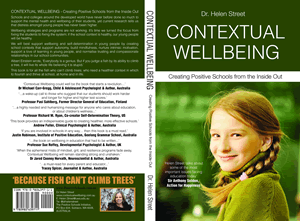 (this is an extract from: Street, Helen (2018) Contextual Wellbeing: creating positive schools from the inside out, published by Wise Solutions)
(this is an extract from: Street, Helen (2018) Contextual Wellbeing: creating positive schools from the inside out, published by Wise Solutions)
… It could be said that we are living in ‘emotional times’, with our focus so largely on finding the happiness we want. Hundreds, if not thousands of popular self-help books try to tell us how to help our children acquire the skills and knowledge for happy and successful living. But is this current focus on happiness a good thing? As my mother puts it, ‘In my day we just sort of got on with life, we knew if things were going OK, and we knew when they weren’t … now it seems that we are encouraged to spend so much time submerging ourselves in our feelings. I am really not sure that is of any benefit … for anyone’s children.’
Here lies the dilemma. Like my mother, I question whether this indiscriminate pursuit of happiness is in danger of diminishing the very quality of our day-to-day existence. Yet, with so many adults and young people living in mental and emotional turmoil, the idea of not focusing our attention on the active pursuit of happiness also seems an incredibly bad idea.
It seems that we need to do ‘something’ to help the young people in our care, yet what that ‘something’ is, remains confused and uncertain. Do we continue to spend time actively teaching the art of happiness to our children, albeit in a new improved program? Or, might we be better off simply encouraging them to engage in a rich and busy life?
To address these conundrums, it is time to look more closely at what wellbeing and happiness are, and how they relate to each other. If we can better and more comprehensively understand wellbeing, we will have a far greater chance of helping ourselves and our children to think about it effectively, or indeed, not think about it so much. Moreover, we may be far better equipped to achieve lasting wellbeing in a meaningful and sustainable way.
So, what are these elusive goals of happiness and wellbeing we all so want to achieve? Is happiness an ongoing state of mind? Is wellbeing a set of optimum behaviours? Does happiness stem from life success, or perhaps something more?
I am guessing that you could easily come up with a basic definition of wellbeing, at least in terms of what works for you. I am also guessing that this definition could quickly become confused or contrary, the more you think about it. At the most general of levels, we all know that wellbeing is something to do with embracing life proactively, but we are aware too that it is also about the acceptance of things we can’t control. Many motivational books suggest that our best foot forward is a creative and self-determined one. Yet just as many books are telling us to slow down from the relentless pursuit of our goals and live life more in the moment. Certainly, trying to come up with a definition of individual wellbeing can quickly seem like a task full of contradictions. At the very least, it is far more than simply feeling or acting in any single way.
I believe that any comprehensive definition of individual wellbeing must include our ability to live well, live happily and to embrace life with passion and purpose. However, it also needs to include our ability to hold sorrow, live productively with grief and find hope in the face of adversity. Our individual wellbeing embraces two sides of every coin of feeling and behaving. ‘Feeling happy’ is just one side of that coin. True wellbeing lies in our ability to express happiness or sadness, as the situation demands it. Lasting wellbeing is all about ensuring that each coin of our various emotions faces the healthiest way up in any given situation. And therein lies the key: ‘any given situation.’ Context matters.
In Mexico, on the annual Day of the Dead, people remember and celebrate the lives of those they have loved and lost. It is believed that death comes in three stages. First, we experience physical death; second, we are buried and third, we are forgotten. It is only when we are forgotten that we are truly considered to be dead. This understanding of death emphasises the importance of our identity beyond our physical form. We reside in every aspect of the context in which we live and die. Just as the boundaries of our physical form define us, so we are defined by the space around us. As much as every aspect of our wellbeing resides in our individual form, so too it resides in the spaces between us, within the cultural norms of our environment and within those with whom we connect.
Have you kept hold of a childhood teddy-bear or doll, sensing that it was alive in some capacity? Have you held onto the clothes or treasured possessions of someone you have lost? Do you see reflections of the people you know in their homes, their gardens, their choice of friends? The very essence of who we are extends so much beyond our physical selves. It resides within the context of our lives as much as it resides within our individual selves. In a similar way, the various elements of wellbeing extend beyond the individual self.
In his 2002 book Authentic Happiness,[i] Martin Seligman defines individual wellbeing across three domains: positive emotions and our experience of them; engagement with the things we do; and our sense of meaning and contribution to society. Since the publication of Authentic Happiness, he added two further domains: healthy relationships and a sense of accomplishment.[ii] These five pillars (positive emotion, engagement, relationships, meaning and accomplishment) are captured by the acronym PERMA, and together they form the basis of the academic and clinical domain of positive psychology.
The idea of engagement as a central notion of living and wellbeing is not new. Two thousand years before today’s version of positive psychology, Plato described the joy that comes from finding passion and immersion in a task. And in the 1970s, philosopher and mythologist Joseph Campbell suggested that we are often caught in a futile search for ‘the meaning of life’ when true happiness is about finding a ‘connection’ with life.[iii] When something grabs you with passion, he said, you need to grab it right back.
This view is taken up in Mihaly Csikszentmihalyi’s 1992 book Flow,[iv] where he talks about wellbeing as a sense of immersion and engagement with the things we do in life. When we are in ‘flow’ we are energised and challenged by what we do. We are caught in the moment to such a degree that time stands still, and then we find ourselves surprised at just how much time has passed. When we are in flow, we experience wellbeing as a state of deep satisfaction.
These expressions of wellbeing and happiness recognise how we as individuals operate within and connect with our social context. Definitions of wellbeing that focus too narrowly on individual characteristics are in danger of becoming meaningless theories of everything. Wellbeing is not simply about individual expressions of thoughts, feelings and behaviours; it is not an isolated or solitary pursuit. It is just as much about the connections we form with others, the tasks we pursue and our wider sense of the world.
Wellbeing concerns our ‘being well’ as social beings, not just human beings. It is about creating and reacting to a social context in a healthy and positive way. Ultimately, lasting wellbeing and happiness have far less to do with any aspect of our individual functioning than we might like to think, and far more to do with the spaces between us …
To continue reading please click HERE to purchase a complete copy of Contextual Wellbeing
[i] Seligman, M. E. P. (2002) Authentic happiness: Using the new positive psychology to realize your potential for lasting fulfillment. New York: Free Press
[ii] Seligman, M. E. P. (2011) Flourishing. New York: Free Press
[iii] Campbell, Joseph (1988) Interview with Bill Moyers – The Power of Myth (New York), 30
Campbell, J. (1993). Myths to Live By. New York, USA: Penguin Group
[iv] Csikszentmihalyi, M (1990) Flow: The Psychology of Optimal Experience. Harper and Row: New York, NY


